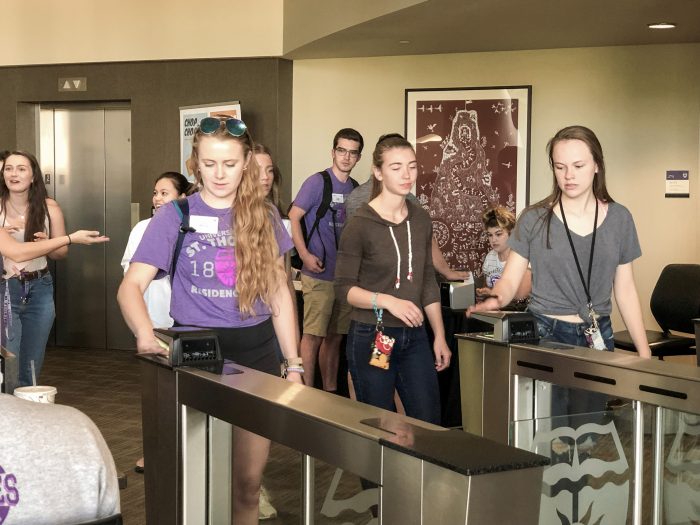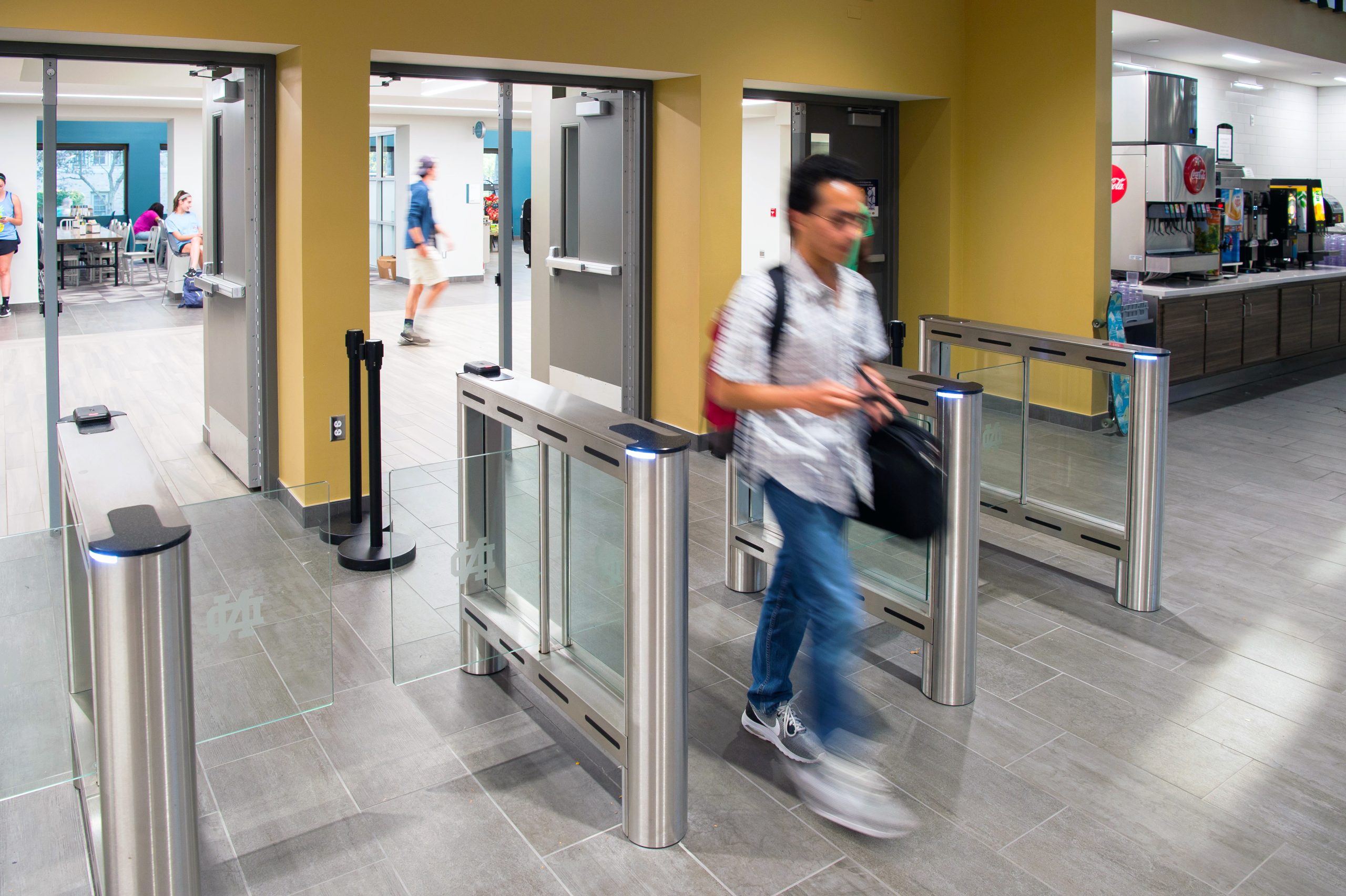Campus safety is a top priority for educational institutions, as well as for the families of current and prospective students. With the increasing concerns surrounding unauthorized access, violence, and other security challenges, campuses are seeking innovative solutions to protect students and staff.
Turnstiles have emerged as an effective solution to address these various security challenges. By providing a physical barrier and integrating with access control systems, turnstiles create a secure environment that deters unauthorized individuals from entering university facilities. In more ways than one, turnstiles significantly improve safety and security on campuses.
1. Controlled Access for Campus Safety
Turnstiles serve as a physical barrier, allowing only authorized individuals to enter campus buildings. By integrating turnstiles with access control systems, universities can ensure that only students, staff, and approved visitors gain entry. This controlled access prevents unauthorized individuals from entering sensitive areas, reducing the risk of theft, vandalism, and other security threats.
Advanced turnstile systems can be equipped with various authentication methods, including card readers, biometric scanners, or mobile credentials. This flexibility allows campuses to choose the most appropriate and convenient method for their community.
Additionally, turnstiles can be programmed to enforce time-based access restrictions. This ensures that certain areas are only accessible during specific hours. This level of control not only enhances security, but also helps manage resources more efficiently in restricting access to buildings that don’t require 24/7 operation.

University of Notre Dame secured by Fastlane turnstiles
2. Tailgating Prevention
Turnstiles are designed to allow only one person to pass through at a time. Tailgating occurs when an unauthorized person follows closely behind an authorized individual to gain entry.
One of the most significant benefits of Fastlane turnstiles is their ability to prevent tailgating. These advanced optical turnstiles use sensor beams to detect tailgating attempts. They can spot these attempts from different angles from following behind, side-by-side, climbing over, or any directional violation.
When an unauthorized entry is detected, a visible and audible alert is triggered. The system also notifies security personnel for an immediate response. By consistently preventing unauthorized access, turnstiles help create a culture of security awareness among students and staff. This encourages more vigilance and compliance to access attempts.
3. Efficient Crowd Management
Turnstiles play a vital role in managing large crowds on campus, such as in residence or dining halls. By streamlining entry and exit processes, turnstiles prevent overcrowding by their excellent ability to handle high volumes of traffic. This not only enhances campus safety but also improves order and the overall experience for students and visitors on campus.
Turnstile systems can be programmed to provide valuable data collected from usage patterns and identify peak hours. This empowers institutions to make informed decisions about resource allocation and facility management. Some turnstiles also feature wider lanes to accommodate wheelchair users or individuals with mobility aids, ensuring ADA compliance and inclusive access for all.
4. Integration with Security Systems
Fastlane turnstiles can be seamlessly integrated with all types of access control or security systems. This creates a comprehensive security network while extending the technological capabilities of the turnstiles. Access control extensions can include biometric readers, mobile credentials, and time-based systems.
The integration capabilities extend beyond basic access control. Turnstiles can be connected to video surveillance systems, allowing security personnel to visually verify identities in real-time. They can also be linked to fire alarm systems, automatically unlocking in the event of an emergency for quick evacuation. Certain access control systems even incorporate facial recognition technology in turnstiles, adding an extra layer of security for high-risk areas.
By serving as a central point of integration for various security technologies, turnstiles become a crucial component in creating a smart, responsive campus security infrastructure.

University of St. Thomas dining hall entrance secured by Fastlane Glassgate 150 turnstile with Idemia MorphoWave integration.
5. Solving Challenges in Facilities
Turnstiles offer a range of solutions tailored down to the specific facility served. From residence halls to dining areas, gyms to libraries, each facility presents its own unique set of security challenges and access control requirements. With the right combination of hardware and software, turnstiles can resolve diverse challenges for campus safety.
Turnstiles can help manage high-traffic flow in busy dining halls. They can ensure round-the-clock security in residence halls. Additionally, they can control access in recreation centers and protect valuable resources in libraries. The power of modern turnstiles lies in their ability to tailor solutions to meet specific needs.
With this flexibility, campus administrators can implement a cohesive security strategy across different facilities. By providing this level of customization, turnstiles not only enhance overall campus safety and security but also improve operational efficiency and user experience in each distinct area they serve.
- Dining Halls: Dining halls often experience high traffic during meal times, making efficient access management crucial. Turnstiles integrated with meal plan systems can ensure only authorized students with valid meal plans enter, manage peak traffic flow efficiently, prevent unauthorized sharing of meal plans, reduce manual labor, and provide accurate data on dining hall usage for resource allocation.
- Recreation Center: Recreation centers face unique security challenges because of their diverse activities and extended operating hours. Turnstiles in these facilities can control access based on membership status or student ID. They can also adjust access rules during games with ticketed visitors.
- Residence Halls: Residence halls are students’ homes away from home, requiring robust security measures to ensure their safety and peace of mind. Turnstiles in these areas can restrict access to residents and authorized guests only, provide 24/7 entry control without constant staff presence, integrate with student ID systems, and log entry/exit data for security audits and emergency situations.
- Libraries: With valuable resources on the line, turnstiles effectively address library security challenges. Libraries benefit from turnstiles by preventing unauthorized access and potential theft of resources, managing capacity and monitoring occupancy levels, ensuring quiet entry/exit process, and ensuring smooth entry for users, enhancing both security and operational efficiency.

Photo by Peter Ringenberg/University of Notre Dame
Community Impact from Campus Safety
By implementing turnstiles on campus, educational institutions can significantly enhance their security measures while maintaining a welcoming environment for students, staff, and visitors. The combination of physical barriers and advanced technology makes turnstiles an effective tool in creating a safer and more secure campus community.
Turnstiles deter unauthorized access while fostering a culture of accountability and awareness among the university’s population. When students and staff see that campus safety is prioritized through thoughtful security measures, it builds trust in the institution’s commitment to their well-being.
A confident sense of security can lead to increased participation in campus activities, higher admission acceptance from prospects, and a stronger sense of belonging within the community. Investing in robust security solutions is essential for fostering a vibrant, safe, and engaged campus community.
This article was reviewed for accuracy by Executive VP of Smarter Security, Clayton Brown
Clayton Brown serves as Executive Vice President at Smarter Security, the leading provider of hand-crafted optical turnstiles, and is a co-founder of ReconaSense, the only FICAM-certified risk-adaptive physical access control solution (RAdPACS) using commercial off-the-shelf (COTS) components. As a member of SIA’s Government Relations Committee and Data Privacy Board, Clayton proudly represents a next-generation of practitioners dedicated to bringing data-driven ideas to existing physical security challenges.

